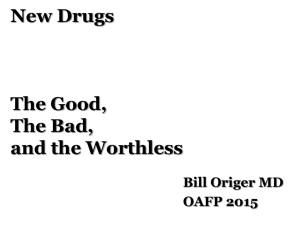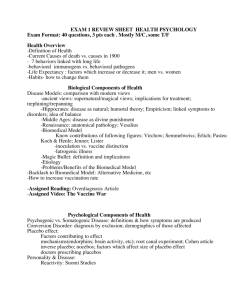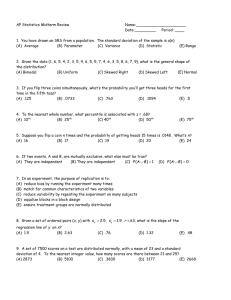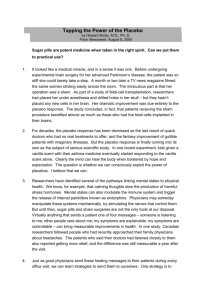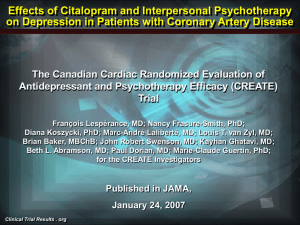New Drugs The Good, the Bad, & the Ugly
advertisement
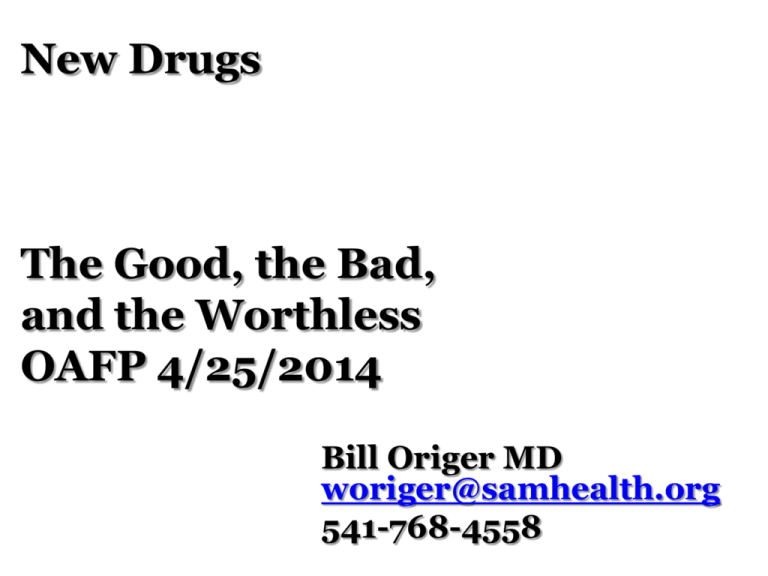
New Drugs The Good, the Bad, and the Worthless OAFP 4/25/2014 Bill Origer MD woriger@samhealth.org 541-768-4558 Disclaimers • • • • • • No commercial financial support After the talk, you will understand why All is based on high quality published research References & boring details available Prices are approximate & may vary New information is continuous, anything could change, and I could be wrong How did I get into this?? • Medical Director, Samaritan Health Plans 2000-06 • Wrote & managed formularies for Oregon Health Plan, Medicare & commercial insurance plans • Used by >400 physicians who know where I live • Oregon Health Resources Commission 2006-11, Chair, Pharmaceutical Subcommittee ‘08-11 • Oregon Preferred Drug List Committee 2010 • Oregon P & T Committee, Chair, 2012-14 Another disclaimer • Research applies to populations • Physicians treat individuals • Medicine has thousands of unique & unusual people and situations • There are times when the first or second choice are not appropriate • Do the right thing for each patient Using this in Health Care Reform • Lowers cost – avoid overpriced brands • Using evidence to improve outcomes • Avoid things that do not work New evidence on old stuff Same efficacy & toxicity within category May be differences in side effects, dosing, duration of action, price • • • • • • • • • • • • Alzheimer’s drugs ACE Inhibitors Angiotensin receptor blockers ADHD stimulant drugs Inhaled steroids for asthma Inhaled nasal steroids β agonists for asthma α blockers for PBH 5 α-reductase inhibitors- BPH Estrogens for menopause Oral contraceptives Muscle relaxants • Benzodiazepine receptor agonist sedatives • NSAIDS • H2 blockers • PPIs • Statins (adjusted for potency) • Triptans for migraine • Anticholinergics & others for overactive bladder • DPE-5 inhibitors for erectile dysfunction • Second generation antidepressants New Anticoagulants for in Atrial Fib • Factor Xa inhibitors: apixaban, betrixaban, darexaban, edoxaban, idraparinux, rivaroxaban. All drugs lumped together • Cochrane review & meta-analysis 42,084 patients, 12-weeks to 1.9 years, ages 65-74 • Comparable to warfarin for stroke preventions & bleeding risk • High heterogeneity of studies, insufficient data on individual drugs New Anticoagulants for Atrial Fib • This is favorable, BUT… • Don’t know which one is best or safest • Potential risks – short acting BID doses, could wear off if dose missed • Still no way to reverse • Results are preliminary, could change • Few long term data JAMA 3/19/2014 New Anticoagulants vs Warfarin • DO NOT use for prosthetic heart valves. • Option for those who cannot take warfarin • Expect higher co-pay & out of pocket expense • If warfarin is working, don’t change • Stay tuned for more info • Many references, most readable: Medical Letter 11/15/2010, 12/12/2010, 10/1/2012, 2/4/2013, JAMA 4/2/2104 It ain't what you don't know that gets you into trouble. It's what you know for sure that just ain't so. Mark Twain “Enough Is Enough: Stop Wasting Money on Vitamin and Mineral Supplements” Editorial Title Annals of Internal Medicine 12/17/2013 “We believe that the case is closed – supplementing the diet of wellnourished adults with most mineral or vitamin supplements has no clear benefit and might even be harmful.” Editorial Annals of Internal Medicine 12/17/2013 Worthless: non-statins for lipids • Bile acid sequestrants, ezetimibe, fibrates, niacin, Ω-3 fatty acids • “Alternatives” if intolerant to statins • Studies are short & poor quality • No decrease in cardiovascular events • Why do something that does not work??? Annals of IM 4/1/2014 The Rise & Fall of Fish Oil The rise: small short term studies showed benefit on surrogate markers Lots of hype & pseudo-science The plateau: larger studies of surrogate markers – mixed results Nobody noticed The fall: large meta-analysis of clinical endpoints – no benefit The hype persists, ignoring facts Vitamin D Remain skeptical • Proposed to benefit almost everything • Mostly observational studies – cannot prove causality • Most evidence is poor quality • Two systematic reviews of observational & randomized trails: no convincing evidence of any benefit • It’s possible that there may be some limited benefit in some populations – don’t know yet BMJ 4/1/2014 Low T is high BS • “Low-T Quiz” is the ultimate of hype • Claims: flagging endurance, poor performance at sports, sleepiness after a big meal, and loss of height, as well as decreased libido could be signs of a “serious testosterone deficiency.” • Facts: T increases libido and cardiovascular risk • Lean muscle mass vs fat – change <5% • Does not: improve strength, endurance, or mood • Won’t make anyone taller • Only proven uses: true hypogonadism: pituitary ablation, radiation, chemo, genetic, etc JAMA Internal Medicine 8/26/2013 Pre-disease is not pathologic No long term benefit of drug treatment for: – Pre-diabetes1 • WHO discarded term in 1980 & 2008 – Pre-hypertension2 • JNC 8 eliminated this term – Subclinical hypothyroidism3 Recommend lifestyle changes, not pills 1) J Am Coll Cardiol 2/14/2012; 2) JAMA 12/18/2013; 3)JAMA IM 10/25/2013 The GOOD Benefits from routine vaccination • In the past 10 years, vaccination has prevented 26 million cases of childhood diseases. • Parents of today do not know polio, measles, pertussis, diphtheria, rubella, mumps, or chicken pox • Vaccination rates are declining NEJM 11/28/2013 Time interval for 95% drop in disease from vaccine 1924 1948 1955 1963 Diphtheria Pertussis Polio Measles NEJM 11/28/2013 19 years 17 years 8 years 5 years Good - Varicella vaccine Licensed in the US in 1995. Second dose added June 2006. Kaiser Permanente of N California: 14 year prospective study of 7585 children who received initial vaccine in 1995. Incidence of varicella in vaccinated children was 15.9/1000 person years, tenfold lower than prevaccine. Cases were mild and occurred early after the first dose. No child developed varicella after the second dose. Effectiveness 90%. No decline in immunity at 14 years. Pediatrics May 2013 Bendectin Rises Again. • Original Bendectin 1956: antihistamine doxylamine, pyridoxine (B6) and anticholinergic dicyclomine. • 1976 dicyclomine removed. • 1983 voluntarily withdrawn due to lawsuits • No evidence of harm in over 30 million pregnant women. • Results: no decrease in birth defects, hospitalizations for hyperemesis doubled. • Both components are available OTC, combined cost of $0.15/dose. • Rx: Diclegis, timed release doxylamine 10mg & pyridoxine 10mg $4.75 per pill, 1-4 doses daily. • Resurrection is expensive. The Medical Letter 8/2/2013; Am J OB-Gyn 12/2010 Medical Therapy = Stenting with Stable Coronary Ischemia • Meta-analysis of 4064 patients, ages 59-64, mostly male, follow-up 5 years • Ischemia identified by stress testing (with or without imaging) clinically stable, ⅓ w diabetes, ⅓ w prior MI Most had >50% occlusion ≥ 2 coronary arteries • Randomized to stenting plus medical therapy, or medical therapy alone: aspirin, β blockers, ACEI or ARBs, and statins. • Endpoints: death, non-fatal MI, angina, or unplanned revascularization, • No difference between groups in any end point. JAMA Internal Medicine Feb 2014 Good with Reservations Hepatitis C • Sofosbuvir (Sovaldi) nucleotide inhibitor, more effective, far fewer side effects • With ribavirin & peginterferon for genotypes 1,3,4, with ribavirin genotype 2 • Also combined with other newer agents • Expensive ~ $65-80,000 for 12 wks plus the cost of other drugs • Cost is so high that treatment will have to be limited The Reservations • Cautions: studies are preliminary, details may change, new drugs are coming • American Association for the Study of Liver Diseases (AASLD) Guideline Committee is industry dominated • Coverage uncertain, target population unclear • Need more practical guidelines • Probably best to wait a year or two Oregon P & T review 3/27/2014 Good –OTC Nasacort • Triamcinolone nasal spray for allergic rhinitis • 2 sprays each nostril once/day for adults • Approximate price: $18-22/month • Comparable to Rx nasal steroids at much lower price The Bad Bad Idea (SGLT2) inhibitors for diabetes Canagliflozin (Invokana) $289.10/mo Dapagliflozin (Farxiga) $289.20/mo Induce renal glycosuria, lower A1C 0.5 – 1.0% Osmotic diuresis, weight loss, risk of hypovolemia, renal failure, and hyperkalemia. • Genital mycotic infections – Women 7.6% vs 1.5% w placebo RR 527%. – Men, 2.7% vs 0.3% w placebo RR 900%. – Are you scratching yet? • • • • • The Medical Letter 5/13/2013, 2/17/2014 Bad Idea from FDA – Zohydro timed release hydrocodone • FDA advisory panel voted 11 to 2 against approval • FDA approved Zohydro, doses 10 to 50 mg per pill, no APAP, tablet is not tamper resistant, can easily be crushed, dissolved, & injected. • The attorneys general of 29 states sent a letter to FDA in Dec asking the agency to reverse the approval. • A bill has been introduced in Congess to reverse the approval Medscape Medical News 12/12/2013 Remain skeptical • Restless leg aka Willis-Ekbom Disease • No objective findings for diagnosis or treatment. No mortality • Diagnosed by questionnaire including telephone version • Uncertain pathophysiology • High placebo response • Drugs with lots of side effects • BMJ 1/4/2014 Dopamine Agonists Pramipexole and Ropinirole • Nausea, orthostatic hypotension and sedation • Sudden episodes of sleep without warning • Impulsive behaviors • Augmentation – may cause worsening of condition • Brands $200-300/mo The Medical Letter 9/5/11, 11/28/11 Gabapentin • Somnolence (20%) dizziness (13%). • Balance disorder, edema, weight gain, blurred vision, disorientation, lethargy and vertigo • Driving impairment 2 to14 hours after dosing. • Branded timed release $200+/mo • Same as placebo in 2 of 3 studies Rip-off: Sitavig (acyclovir) for oral herpes • • • • • “Mucoadhesive “ 50 mg tab Stick it on mucosa next to new lesion Theory: high local concentration Fact: rip-off Mean healing time Sitavig 7.05 days Placebo 7.62 days • Price ??? Reference: Public Assessment Report submitted to FDA 12/18/2012 And now, The Worthless Overpriced & Mediocre paroxetine (Brisdelle) for hot flashes • SSRIs have a very modest effect on menopausal hot flashes. • Brisdelle 7.5 mg paroxetine, at bedtime. • Reduced hot flashes from 7-8/day by 1.4 hot flash/day over placebo. • Cost $135/month, vs. $4/month for generic paroxetine 10 or 20mg. • The Medical Letter 10/28/2013 Overpriced & Mediocre vortioxetine (Brintellix) for depression New serotonergic antidepressant. • Studies were short, under 8 weeks. Results were mixed, some showed clinical benefit, and some did not. • Sexual dysfunction – Women 34% vs 20% with placebo – Men 29% vs 14% with placebo. • $218/month. • “Other antidepressants are preferred.” The Medical Letter 11/25/2013 Worthless - Soy protein to prevent recurrence of prostate cancer. • 177 men at high risk of recurrence after radical prostatectomy • Intervention: 20 gram daily of soy protein isolate, or placebo. Randomized, double blind, seven US research sites • End point: rise in PSA over two years • Result: no difference from placebo. JAMA 7/10/2013 Worthless -Saw palmetto for BPH • Saw Palmetto compared to placebo or standard medications. • Population: 5666 men, average age 65 in 25 RCTs, lasting 4 to 72 weeks. • Endpoints: Self-rated symptoms scores, peak urine flow rate, nocturia, and physician symptom rating • Results: improvement in self-reported symptoms, no change in urinary flow, physician assessment, or standardized rating scales. • Cochrane Review 2012, cited in Journal Club, Archives of IM 5/21/2013 Worthless– SNRI antidepressant levomilnacipran (Fetzima) • Isomer of milnacipran (Savella) which is modestly effective for fibromyalgia. • Side effects of nausea, constipation, hyperhidrosis, palpitations, urinary hesitancy and erectile dysfunction 6-17% of patients. • Six 8 week controlled studies: 6-10% better than placebo • $203/month . Generic SSRI $4/mo. • Medical Letter recommends using existing SSRIs and SNRIs instead of levomilnacipran. The Medical Letter 12/23/2103; Int J Clin Pract 11/2013 Worthless -Cranberry products for UTI prevention in high risk populations. • Cranberry products (tablets, capsules, juice, and concentrated juice extract) • Compared to placebo, no treatment, antibiotic, or probiotic. • Population: >2 UTIs in past year, elderly, patients w indwelling or intermittent catheters, pregnant women, and children with >1 prior UTI. • Endpoint: documented symptomatic UTI. • Results: Cranberry - better than probiotics, same as placebo. • Conclusion: “Cranberries should be recommended for their culinary, rather than therapeutic potential.” Cochrane Review 2012, cited in Archives of IM 5/21/2013 Worthless Metformin for childhood obesity. • Used off-label in non-diabetic children for weight loss. • Meta-analysis by OHSU of randomized trials of non-diabetic children with BMI >25 or BMI for age >85th percentile. 14 trials with 946 children, ages 10-16. • Modest benefit at 6 months – wt loss 3.6% • No difference from controls at 12 months. JAMA Pediatrics Feb 2014 DPP-4 inhibitors for diabetes – no cardiovascular benefit • Saxagliptin (Onglyza) and alogliptin (Nesina.) • Added to standard treatment with other oral hypoglycemics and CV drugs. • No CV benefit or risk over 1½ to 2 years. Rate of hospitalization for CHF was increased with saxagliptin. NEJM 10/3/2013 Bad idea - expensive hydrocodone cough syrup • 2 cheap components – 4mg chlorpheniramine and 5mg hydrocodone • Brand name cough syrup (Vituz) $77 for 120cc. • No clinical studies were required for FDA approval. • “ Vituz might reduce coughing in some patients, but as with other similar combinations, its potential harms, especially in the elderly, outweigh its potential benefits.” The Medical Letter 11/25/2013 Reliable Information • The Medical Letter • The Cochrane Collaboration • Meta-analysis in peer-reviewed journals • Oregon P & T Committee http://pharmacy.oregonstate.edu/drug_policy/ pharmacy-therapeutics Click on “Drug class reviews” and “Drug evaluations” Remain Skeptical

